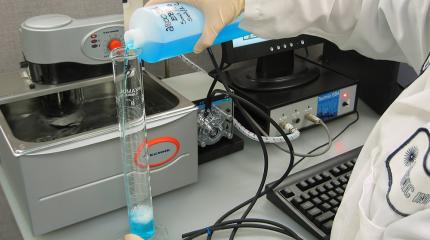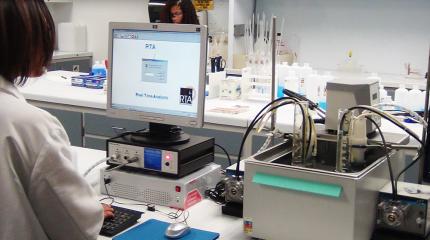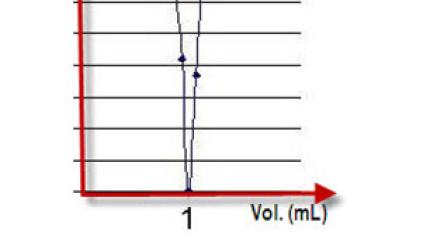Volumetric Analysis "Titration" is one of the oldest methods in Analytical Chemistry. But its simplicity, universality, and speed places titration among the most reliable and versatile quantitative analytical methods. Stoichiometric chemical reactions allow to determine the species directly without needs for calibration. Titration is the primary method of determining the concentration chemicals at high concentration, however for some analysis it can have quite low detection limits (ppm).
Depending on the type of chemical reaction, titration methods can be divided into the four major categories:

Acid/Base Titration
An acid-base titration is the determination of the concentration of an acid or base by exactly neutralizing the acid or base with an acid or base of known concentration. This allows for quantitative analysis of the concentration of an unknown acid or base solution. It makes use of the neutralization reaction that occurs between acids and bases. pKa and Ka (acid constants) can also be determined from a pH titration graph.
Acid-base titrations can also be used to find percent purity of chemicals.

Redox Titration
A redox titration is a type of titration based on a redox reaction between the analyte and titrant. Redox titration may involve the use of a redox indicator and/or a potentiometer. A common example of a redox titration is treating a solution of iodine with a reducing agent to produce iodide using a starch indicator to help detect the endpoint. Iodine (I2) can be reduced to iodide (I−) by e.g. thiosulfate (S2O32−), and when all iodine is spent the blue color disappears. This is called an iodometric titration.
Most often of all, the reduction of iodine to iodide is the last step in a series of reactions where the initial reactions are used to convert an unknown amount of the solute (the substance being analyzed) to an equivalent amount of iodine, which may then be titrated. Sometimes other halogens (or haloalkanes) than iodine are used in the intermediate reactions because they are available in better measurable standard solutions and/or react more readily with the solute. The extra steps in iodometric titration may be worth while because the equivalence point, where the blue turns a bit colourless, is more distinct than some other analytical or may be by volumetric methods.
The main redox titration types are:
- Redox titration - Titrant
- Iodometry - Iodine (I2)
- Bromatometry - Bromine (Br2)
- Cerimetry - Cerium(IV) salts
- Permanganometry - Potassium permanganate
- Dichrometry - Potassium dichromate

Complexation Titration
Complexometric titration (sometimes chelatometry) is a form of volumetric analysis in which the formation of a colored complex is used to indicate the end point of a titration. Complexometric titrations are particularly useful for the determination of a mixture of different metal ions in solution. An indicator capable of producing an unambiguous color change is usually used to detect the end-point of the titration.when is the complexometric titration is known as chelatometry titration.

Potentiometric Titration
Potentiometric titration is a technique similar to direct titration of a redox reaction. It is a useful means of characterizing an acid. No indicator is used; instead the potential is measured across the analyte, typically an electrolyte solution. To do this, two electrodes are used, an indicator electrode (the glass electrode and metal ion indicator electrode) and a reference electrode. Reference electrodes generally used are hydrogen electrodes, calomel electrodes, and silver chloride electrodes. The indicator electrode forms an electrochemical half-cell with the interested ions in the test solution. The reference electrode forms the other half cell.
The overall electric potential is calculated as Ecell = Eind - Eref + Esol. Esol is the potential drop over the test solution between the two electrodes. Ecell is recorded at intervals as the titrant is added. A graph of potential against volume added can be drawn and the end point of the reaction is halfway between the jump in voltage. Ecell depends on the concentration of the interested ions with which the indicator electrode is in contact.

Precipitation Titration
This is a special type of titration that involves formation of precipitates during the course of titrant addition. The titrant react with the analyte forming an insoluble material and the titration continues till the very last amount of analyte is consumed. The first drop of titrant in excess will react with an indicator resulting in a color change and announcing the termination of the titration.
Example: AgNO3+ NaCl à AgCl + NaNO3
